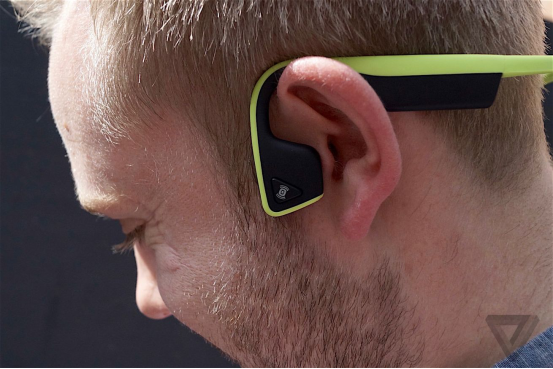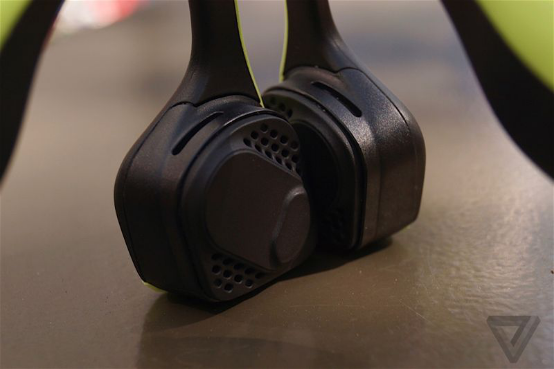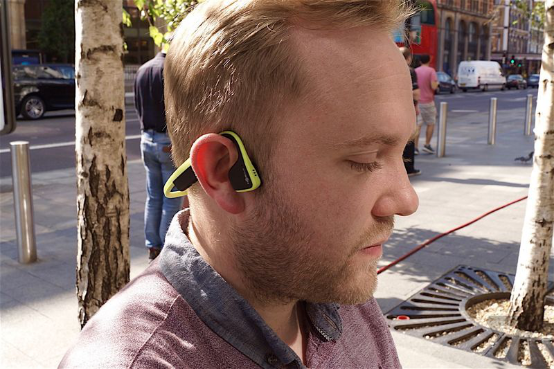Bone conduction sports headset experience is actually excellent enough

The Verge Chinese Station reported on October 26
The transmission of sound is through vibration. This is common sense that many of us know, but the more we think about it, the more we seem to wonder. We live in a world full of material. Everything will vibrate. When we touch or hit an object, it will start to vibrate, and then the sound will spread through the surrounding air. The air with vibrating sound waves moves directly into our ears through continuous movement, alternating and high and low pressure movements, through the bounce of buildings, trees, and the human body. And these vibrations are converted into sound signals that are received by our brains.
It sounds like the sound is very complicated. Is there any simpler and better way?
Of course, there is indeed a better choice now. In the past few weeks, I have been experiencing a pair of earphones using bone conduction technology, and bone conduction technology has been a century of history. Yes, this time I experienced the Trekz Titanium bone conduction headphones from Aftershokz. The price is 130 US dollars (about 880 yuan). Initially this company was a supplier of military bone conduction equipment, and through the efforts of the past few years, Aftershokz system has further promoted this technology in the civilian market.
Unlike ordinary sound propagation through air vibrations, bone conduction headphones take a more direct approach, transmitting vibrations directly through the facial bones to the inner ear and then into the brain. This is a strange and somewhat crazy idea, at least initially I was still unacceptable.

First of all, bone conduction headphones sounds very different from ordinary headphones. There are many factors here, and the most important one is that we want to transmit sound through our kneeling vibrations. In fact, we consume more energy than air vibrations. Some people with common sense know that the structure of hard molecules is more closely linked. Therefore, if you want to let the molecules vibrate through the gap, you need more energy. Therefore, this means that we need to increase the volume of bone conduction headphones unless it always touches our skin.
This feels very strange.
Although this feeling is not terrible, it always makes people feel that there is no end in the dessert. When I first experienced Trekz Titanium bone conduction headphones, I personally felt that the magnitude of the actual vibration was obvious. When used as if someone was gently hitting my head, although not unpleasant, it always distracted me. But when I brought a pair of headphones, I felt the unique experience of bone conduction headphones. Listening to the squeaky voice of Willy Wonka, the headphones leaped over our faces and it was wonderful.

I need to remind everyone again that the sound is vibration. Interestingly, the first patent on bone conduction technology was a science fiction novel that appeared in 1924. It was not used as a morgue because it was a pair of rubber plates that passed sound through the teeth. And after a century, we have already begun to appreciate all kinds of music through this technology.
This is not to say that bone conduction technology is not good. Trekz Titanium bone conduction headphones are basically similar in sound quality to a $30 (about RMB200) headset, and have some obvious drawbacks, such as low sound and bass. weak.

However, bone conduction headphones also have the obvious advantage that they can liberate our ears. We don't need to put the earphone close to the ear, we can hear the sound of the outside while listening to music, such as the bird, the whistle of the car, so it is completely isolated from the outside world.
This means that we will not be completely isolated by music. In some cases, this is a good thing. The positioning of the Trekz Titanium is a sports headset, so many young people will choose to enjoy music while running or cycling. The characteristics of bone conduction technology allow users to listen to the sound of the outside world while listening to music, improve the security, both at the same time.
This is also the biggest advantage of the bone conduction technology headset. When we ride in the city, if we choose ordinary headphones to listen to music, we will always worry that we can not hear the car whistle. Even if you are on the road, too loud music can lead to danger. I don't want to blame all the accidents on the headset, but at least ordinary headphones will isolate us from the world around us and turn it into a completely private space. And if it is at home, of course, the better the sound insulation, the more we can immerse ourselves in the world of music. But in the open, we really should hear what other people are saying and what voices we need to receive.

When it comes to technology, the Trekz Titanium bone conduction headset is not much different from an ordinary earphone. It directly transmits the sound to the inner ear through vibration, and then adjusts the volume by the amplitude of the shock. In fact, the Trekz Titanium can still be considered as a small speaker that is not inserted into the ear canal. In the noisy outdoor environment, people can't hear Trekz Titanium's voice, no matter whether they are standing in line or in a cafe. But if you are in a very quiet situation, you can still hear a trace of sound.
All of these factors add up. It can be said that bone conduction headphones and ordinary headphones are not completely competitive products. In different scenarios, they can achieve different effects. If you want to experience better sound quality, then you still need to choose those ordinary head-mounted or in-ear headphones. However, Trekz Titanium is even more recommended if you want to ensure safety when exercising outdoors. The Trekz Titanium is comfortable to wear and has excellent battery life, making it more suitable for use when cycling.
But anyway, no matter what kind of headphones, don't forget that the transmission of sound depends on vibration. (Author: James Vincent compilation: Human)
Source: The Verge
The Chinese related rights of the works of The Verge in the United States belong to Tencent Corporation and may not be reproduced or excerpted without authorization.